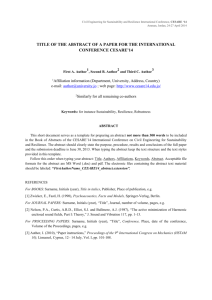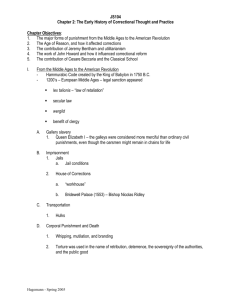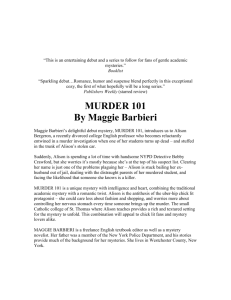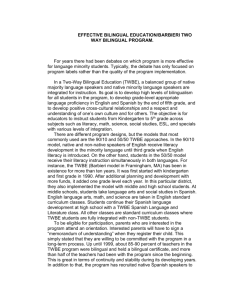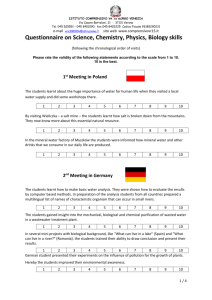Padua
advertisement
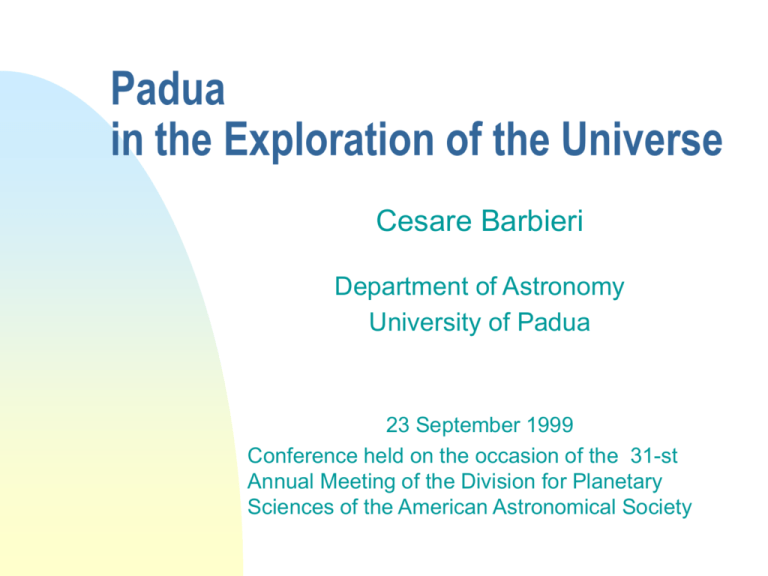
Padua in the Exploration of the Universe Cesare Barbieri Department of Astronomy University of Padua 23 September 1999 Conference held on the occasion of the 31-st Annual Meeting of the Division for Planetary Sciences of the American Astronomical Society Introduction The aim of this conference is to provide a short history of the astronomical studies in Padua, and a brief (and necessarily incomplete) account of the present situation and foreseeable developments. I wish to thank the many colleagues who helped with the documentation. Cesare Barbieri, 23 September 1999 Index A brief history up to 1950 The modern epoch: Giuseppe Colombo, Leonida Rosino , Nicolo’ Dallaporta Italy joins ESA and ESO Observations, theories, space missions Cerenkov light, gravitational waves A panoramic on the future Conclusions To know more Cesare Barbieri, 23 September 1999 Padua: Old Padua XVII Century Cesare Barbieri, 23 September 1999 City University, Astronomical Observatory, Research Institutes Accademia de’ Ricovrati (1599) Accademia Galileiana Patavina di Scienze Lettere e Arti Bishops, Colleges …... A Brief History - 1 Pietro d’Abano (c. 1250 - c.1315) teaching of the ptolemaic system Giovanni Dondi dall’Orologio (1318 - 1389) the astrarium: a mechanical model of the ptolemaic system Cesare Barbieri, 23 September 1999 A Brief History - 2 Galileo Galilei in Padua (1592 - 1610) Cesare Barbieri, 23 September 1999 A Brief History - 3 L’Accademia de’ Ricovrati (1599) (Accademia Galileiana Patavina di Scienze Lettere e Arti) Geminiano Montanari (1633 - 1687) Comet Halley St. Gregorio Barbarigo (1625 - 1697) the professors the Specola of the Seminario the printing house the laboratory of physics Cesare Barbieri, 23 September 1999 A Brief History - 4 Giuseppe Toaldo (1719 -1797) the Specola (decree of the Republic of Venice, 1761), meteorology, (extra-solar planets) Giovanni Santini (1787 - 1877) cometary orbits, Cataloghi Padovani of stellar positions, Lezioni of Astronomy and Optics Giuseppe Lorenzoni (1843 - 1914) astronomical photometry and spectroscopy, geodesy Cesare Barbieri, 23 September 1999 The Specola of Padua (1767) Cesare Barbieri, 23 September 1999 A Brief History - 5 The Mathematicians Gregorio Ricci Curbastro (1853 - 1925) Tullio Levi Civita (1873 - 1941) Tensor Calculus and General Relativity Mechanics Cesare Barbieri, 23 September 1999 A Brief History - 6 Bruno Rossi (1905 - 1993) Antonio Rostagni (1904-1988) Cesare Barbieri, 23 September 1999 The Institute of Physics (1938) The East - West asymmetry of cosmic rays Cosmic rays observations using balloons A Brief History - 7 Giovanni Silva (1882 - 1957) The Astrophysical Observatory of Asiago (1942) Cesare Barbieri, 23 September 1999 A Brief History - 8 Geodetic Astronomy G. Ciscato E. Soler, Rector Cesare Barbieri, 23 September 1999 the polar motion and the International Latitude Service the contribution to the Carloforte station (founded in 1899): Ciscato, Bianchi Soler, Boaga, Tomelleri The Modern Epoch Giuseppe Colombo Leonida Rosino Nicolo’ Dallaporta Italy joins the European Space Agency and the European Southern Observatory The space telescopes, the Center for Space Activities (CISAS) Cerenkov light and gravitational Waves Cesare Barbieri, 23 September 1999 Giuseppe Colombo (1920 - 1984) Celestial Mechanics, rotation of Mercury, space navigation the GIOTTO mission and the InterAgency Consultative Group space geodesy Cesare Barbieri, 23 September 1999 Leonida Rosino (1915 - 1997) The Schmidt telescopes and the Cima Ekar Observatory variable stars, Novae and Supernovae open and globular clusters diffuse and planetary nebulae the Corso di Laurea in Astronomy Cesare Barbieri, 23 September 1999 Nicolo’ Dallaporta Cesare Barbieri, 23 September 1999 Evolution of the Solar System, Stars and Galaxies General Relativity Theoretical Cosmology The Anthropic Principle Science, Metaphysics, Faith Telescopes and their Instrumentation, Observations, Theories and Models, Space Missions Cesare Barbieri, 23 September 1999 The Observing Station L. Rosino at Cima Ekar Cesare Barbieri, 23 September 1999 The 3.5 m National Telescope Galileo (TNG): Active Optics Cesare Barbieri, 23 September 1999 The TNG - Adaptive Optics Speckle mode K-band, FWHM = 0”.35 Cesare Barbieri, 23 September 1999 Detectors, Instrumentation, Controls, Data Archives From the first CCD for the 182 cm (1984) to the OIG TNG (1998) Cesare Barbieri, 23 September 1999 Image Intensifiers, photon counters, solid state devices, … OIG (the visual camera for the TNG), SARG (the high resolution spectrograph for the TNG) Data archives: Guide Star Catalogue II, ... SARG and a first comparison spectrum Solar System - 1 Searching for meteorites in Antarctica Meteorites Lunar Sodium Asteroids and Comets Iron meteorite Acqueous Alteration in the spectra of asteroids Cesare Barbieri, 23 September 1999 H2O+ in Kohoutek comet Solar System - 2 Na cloud around Io Sodium in the Giovian system and in comets Pluto Na tail in comet Hale-Bopp Pluto - Astrometry and HST-FOC image Cesare Barbieri, 23 September 1999 Solar System - 3 Formation models of planetesimal accumulation and formation of planetary embryos in the terrestrial region at 105 years at 106 years Cesare Barbieri, 23 September 1999 Extra-solar Planets, Low Mass Stars dynamical model of extra- solar planets on close orbits formation of planets around binary stars Cesare Barbieri, 23 September 1999 Gliese 623 - HST FOC Stellar Evolution - 1 The final destiny of stars depends on the initial mass of the central core White Dwarfs Abscissa: central temperature Ordinate: density Cesare Barbieri, 23 September 1999 Supernovae Stellar Evolution - 2 Open Clusters Evolution of the stars in an open cluster including the so-called overshooting process; the cluster turns out to be older than in previous theories. Cesare Barbieri, 23 September 1999 Globular Clusters - 1 NGC 6397: the cluster with the smallest distance modulus The proper motions measured with HST permit to isolate the sequence of stars down to masses smaller than 0.1 Mo , namely down to the limit of the hydrogen burning reactions. Cesare Barbieri, 23 September 1999 Globular Clusters - 2 Pal 1: the youngest globular cluster in the Milky Way (about 8 billion years) Cesare Barbieri, 23 September 1999 Globular Clusters - 3 The Bulge-halo Connexion An H-R diagram in the near IR of the galactic bulge, down to stars of mass 0.15 Mo The ages of the bulge and of the halo, both very old systems Cesare Barbieri, 23 September 1999 Planetary Nebulae M 57 with OIG at the TNG H O III 3D Tomography in different spectral lines Cesare Barbieri, 23 September 1999 N II Variable Stars Flare stars, binaries Cataclismic variables, evolution and connexion with solar actvity Simbiotic stars Flare in the Pleiades M57 - TNG Cesare Barbieri, 23 September 1999 Simbiotic stars Solar stars in nova GK Persei Novae FH Ser 1970 25 years after the explosion Recurrent Nova RS Oph Novae as extra-galactic distance indicators: absolute magnitude as function of the decline rate. Dashed line: theoretical track as function of the mass of the White Dwarf. Cesare Barbieri, 23 September 1999 In the Milky Way In M31 and in M33 Supernovae -1 Discovery and classification SN 19991 - The discovery with OIG-TNG The light-curve of SN-I Cesare Barbieri, 23 September 1999 The VST, almost hidden among the 4 VLT, for the discovery of SNs Supernovae - 2 Search of SNs Associated to Gamma Bursts Supernova 1998bw associated to the Gamma Burst GRB 980425 The discovery, the light curve, the spectum Cesare Barbieri, 23 September 1999 Supernovae - 3 The High Redshift SNs Discovery and spectum of a high redshift SN Hubble diagram for nearby and distant SNs Cesare Barbieri, 23 September 1999 Distant SNs and the structure of the Universe, almost surely of low density, and in perennial expansion probably with a positive acceleration Relativistic Astrophysics - 1 SS 433 Pulsar in the Crab Pulsar in the Crab Cesare Barbieri, 23 September 1999 Relativistic Astrophysics - 2 The Structure of a Black Hole NGC 4261 from ground from HST relativistic model of an accretion disc Cesare Barbieri, 23 September 1999 Galaxies - 1 Morphology, rotation curves, dark mass Theoretical models of elliptical galaxies Growth of the apparent dimensions of M87 from 1932 to 1969 thanks to the improvements in image acquisition and analysis Cesare Barbieri, 23 September 1999 Tidal Effect of a dark halo Galaxies - 2 NGC 5128 Cesare Barbieri, 23 September 1999 Elliptical galaxies: halos, anisotropies, triaxiality Counter-rotation between gas and stars Stellar Populations in the Galaxies of the Local Group H-R diagram of a dwarf galaxy formed by stars of successive generations, of ages varying from 108 to 1.3x1010 years Phoenix, a nearby galaxy resolved in stars: the blue ones are young stars overimposed to an older population Cesare Barbieri, 23 September 1999 Theoretical Synthesis of Spectra of Normal Galaxies Comparison between observations (upper lines) and theory (lower lines) Ellipticals Cesare Barbieri, 23 September 1999 Spirals Sa Spirals Sc Active Galaxies: the Nuclear Region Optical jet of the Radiogalaxy (also a BL Lac) Pks 0521-365 from ground and space a) jet plus galaxy b) only jet compact emission at 0”.3 ESO -NTT Cesare Barbieri, 23 September 1999 HST NGC 6240: An Active Galaxy with Violent Star Formation 4m Mayall HST-FOC Interaction among two galaxies. The HST image shows two nuclei resolved in a series of structures hosting an intense and rapid stellar formation. Cesare Barbieri, 23 September 1999 Two Clusters of Galaxies at an Intermediate Redshift Calibration of the extragalactic distance scale from the surface brightness of the clusters of galaxies Cesare Barbieri, 23 September 1999 Quasars Optical variability of 3C 345 The luminosity function of bright QSOs The Ly-alpha forest Cesare Barbieri, 23 September 1999 The Formation of Cosmic Structures Cesare Barbieri, 23 September 1999 Numerical Simulation of a large cluster of galaxies having a mass of 1015 Mo/H and a scale of 6 Megaparsec, made with a parallel supercomputer Cray T3E The Sunyaev-Zeldovich Effect and the Hubble Constant H0 Direct measurement of the distance scale in the Universe Comparison among the S-Z isophotes and the X-ray surface brightness Cesare Barbieri, 23 September 1999 Hubble diagram for a series of clusters of galaxies from the comparison of X-ray data and measures of the S-Z effect The Spectrum of the Extragalactic Background in the Far InfraRed The background radiation between 10 and 1000 micron is dominated by a population of galaxies strongly evolving with the cosmic time. Therefore the vision in the optical band of the primordial Universe is severely limited. Cesare Barbieri, 23 September 1999 The European Giotto Mission Cesare Barbieri, 23 September 1999 The Halley Multicolour Camera The nucleus of Halley’s comet The European Hipparcos Mission: Astrometry at the Milliarcsec level The preparatory colloquia Cesare Barbieri, 23 September 1999 The scientific results: calibration of the RR Lyrae magnitudes UVCS on the Solar Heliospheric Observatory The instrument The solar corona Cesare Barbieri, 23 September 1999 HASI: the Instrument for Titan’s Atmospheric Structure In flight on the Huygens probe of the Cassini spacecraft toward Saturn and Titan Cesare Barbieri, 23 September 1999 Cerenkov Light and Gravitational Waves Cosmic Rays, CLUE and future expansions Gravitational Waves CLUE (Roque) Cesare Barbieri, 23 September 1999 Auriga (Legnaro) Projects for the Future Wide field prime focus for the telescopes VST, LBT and TNG The European missions Rosetta, Mars Express, FIRST/Planck Earth Surveys from space and (hopefully): astronomical instruments on the International Space Station Missions to Mars e Mercury The European Astrometry Mission Gaia Astrobiology The UltraLarge Telescopes Cesare Barbieri, 23 September 1999 The Prime Focus for the Large Binocular Telescope The optical design The mechanical structure Cesare Barbieri, 23 September 1999 The Near-IR Prime Focus of the TNG Spectral range from 1.0 to 2.5 micrometres with a HgCdTe sensor Cesare Barbieri, 23 September 1999 The European Mission Rosetta (2003-2013) Encounters with the asteroids Otawara and Siwa, and orbit around Comet P/Wirtanen Cesare Barbieri, 23 September 1999 Wide Angle Camera The European Mission Mars Express (2003) The Planetary Fourier Spectrometer (PFS) for the study of the atmosphere and of the soil of Mars Cesare Barbieri, 23 September 1999 The European Mission FIRST/Planck (2007) from COBE to Planck Cesare Barbieri, 23 September 1999 GAIA - The Future Mission for Microarcsec Astrometry Spectroscopy in the nearIR in preparation of the mission Cesare Barbieri, 23 September 1999 Public Outreach Catch the Stars in the Net! www.pd.astro.it/stelle.html Voyage in the Cosmos (the exibition of 1997, in the Internet and a CD-Rom) Impacts (in the Internet since 1999) Cesare Barbieri, 23 September 1999 Exhibitions Halley and Giotto (1985 - 1986) From Galileo to GALILEO (1996) That Night on the Moon (1999) Cesare Barbieri, 23 September 1999 Conclusions High visibility in the world-wide community Possible future expansions: - the new frame of the Istituto Nazionale di Astrofisica (INAF) - consolidation of the structure of Space Activities Cesare Barbieri, 23 September 1999 To Know More Cesare Barbieri, 23 September 1999 www.pd.astro.it cisas.unipd.it www.dei.unipd.it www.infn.it
